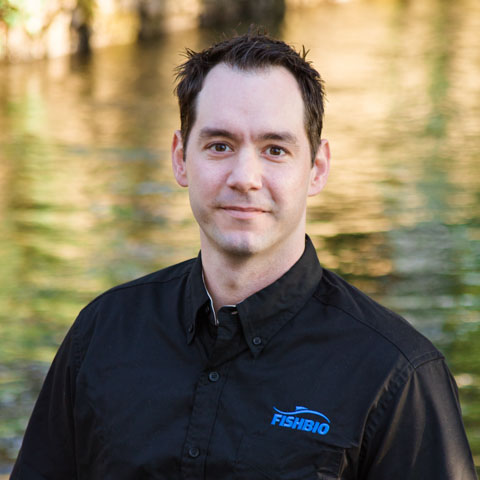


Michael Hellmair is a fisheries biologist with broad expertise in statistical modeling techniques, analysis, and sampling design in fisheries research. In California, he has evaluated juvenile and adult salmonid habitat use in Central Valley streams, investigated fish diet composition, and coordinated observational fish abundance surveys. He has also applied molecular techniques such as microsatellite genotyping for genetic stock identification and assessing genetic variation in fish populations. Michael has extensive experience in fisheries field sampling techniques, including electrofishing (backpack and boat), seines, gill nets, traps, long lines, trawls, and mark-recapture techniques (external tags, PIT tags, and chemical/calcein marking). He is also experienced in database management and modeling using the programming language of R.
Michael worked for two years as a fisheries biologist in Austria, where he co-chaired a scientific advisory panel to monitor and regulate an international lake fishery, and assisted with various aspects of hatchery operation, such as broodstock acquisition, spawning, and rearing fish for conservation and fishery supplementation. Michael holds a master’s degree in fisheries biology from Humboldt State University, where his research focused on determining age and growth characteristics of the endangered tidewater goby using otolith microstructural analysis.
Eschenroeder, J.C., M.L. Peterson, M. Hellmair, T.J. Pilger, D. Demko, and A. Fuller. 2022. Counting the parts to understand the whole: Rethinking monitoring of steelhead in California’s Central Valley. San Francisco Estuary and Watershed Science, 20(1). DOI: 10.15447/sfews.2022v20iss1art2
Peterson, M.L., D.J. Lee, J. Montgomery, M. Hellmair, A. Fuller, and D. Demko. 2020. Stability in reproductive timing and habitat usage of Chinook salmon across six years of varying environmental conditions and abundance. Fisheries Management and Ecology 2020;00: 1–18. DOI: 10.1111/fme.12421
Hellmair, M., M. Peterson, B. Mulvey, K. Young, J. Montgomery, and A. Fuller. 2018. Physical Characteristics Influencing Nearshore Habitat Use by Juvenile Chinook Salmon in the Sacramento River, California. North American Journal of Fisheries Management 38:12. DOI:10.1002/nafm.10201
Kinziger, A.P., M. Hellmair, S.R. Fong, D.H. Goodman and H. Kelsey. 2016. Evolution of rough sculpin (Cottus asperrimus) genetic divergence and late Quaternary displacement on the Hat Creek fault, California, USA. Conservation Genetics 17: 1257-1267. DOI:10.1007/s10592-016-0859-9
Kinziger, A.P., M. Hellmair, W. T. McCraney, D.K. Jacobs and G.Goldsmith. 2015. Temporal genetic analysis of the endangered tidewater goby: extinction–colonization dynamics or drift in isolation? Molecular Ecology 24: 5544–5560. DOI:10.1111/mec.13424
Hellmair, M., and A.P. Kinziger. 2014. Increased extinction potential of insular fish populations with reduced life history variation and low genetic diversity. PLoS ONE. 9(11): e113139. DOI:10.1371/journal.pone.0113139
Kinziger, A.P., M. Hellmair, J.C. Garza and D.G. Hankin. 2013. Contemporary population structure in Klamath River basin Chinook salmon revealed by analysis of microsatellite genetic data. Transactions of the American Fisheries Society 142: 1347-1357. DOI:10.1080/00028487.2013.806351